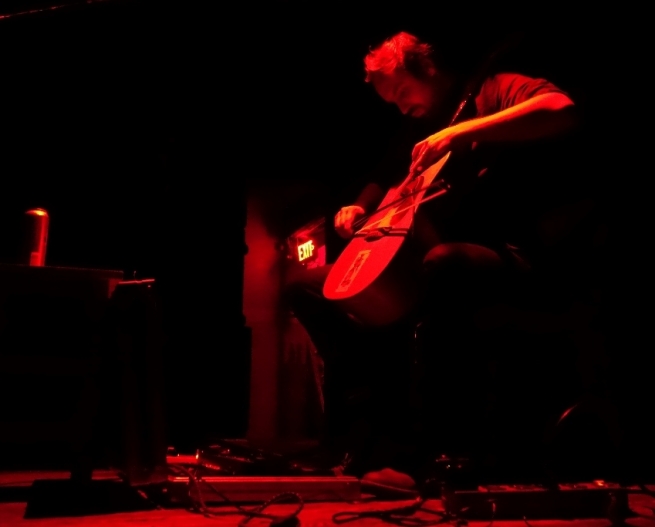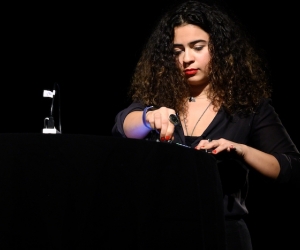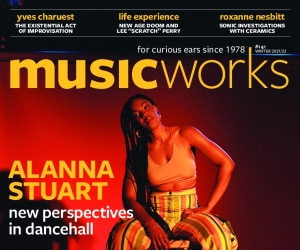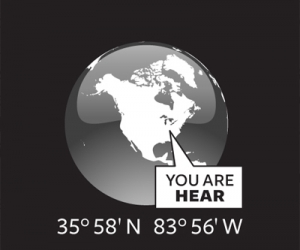
Vancouver-based bowed guitarist Caton Diab (who composes as C. Diab) makes sonorous music that you feel deeply. Primarily crafted on an acoustic guitar with a pickup, effects pedals, a loop station, and bow, Diab’s textured and mournful tones rattle your bones and settle into your heart, coaxing you into acknowledging your emotions.
Diab has referred to his work as “post-classical grunge” as well as “Cascadian guitar music.” When Diab was four years old, his family moved from Carleton Place, Ontario, to the northern part of Vancouver Island, and its Cascadia bioregion made a profound mark on the musician. “I’m an Arabic-European mix, and I don’t really feel like I have a place,” Diab says over the phone, while walking around his Vancouver neighbourhood. “But there’s one place in my life that entirely fulfills me. It is who I am. When I close my eyes at night to go to my happy place, I’m going into the woods in northern Vancouver Island.
“When I put the bow to the guitar and have the right effect, suddenly I’m in a forest or an ocean. If you were to listen to my music while walking through the woods, hopefully it sounds a bit like a tree bending. Hopefully the sound of a bowed string sounds like a whale breaching.”
Diab stumbled upon the technique of bowing his guitar. When he was a teenager, and his family was living in Vancouver Island’s Cowichan Valley, Diab was one of three guitarists in a local psychedelic folk-rock band and struggled to find his place. While jamming at a friend’s house, Diab picked up a discarded bow and began to bow his guitar strings. The reverberated notes felt like the perfect addition to the band’s sound.
It wasn’t until a few years later when Diab, now living in Vancouver, started to compose bowed guitar music intently. He began to experiment with effects pedals and loops, refining his bowing technique and compositional style along the way. “If you listen to all of my records in a row, they actually reflect the trajectory of how I learned to play bowed guitar,” he says.
In 2013, Diab released his first collection, Interludes; he released Beacons the following year. On No Perfect Wave (2016) and Exit Rumination (2018), both released through Injazero Records, Diab incorporates trumpet, an instrument he taught himself to play, and his soundscapes are richer.
On his latest LP, White Whale, released in June 2020 through Injazero Records, Diab expands his sonic palette further with flute and synthesizer, instruments he also taught himself to play. Diab says that White Whale, which he calls his “urban record,” was largely inspired by the gentrification happening in Vancouver. The trees that bend on White Whale threaten to break. On songs like “East Vanished,” the squealing, distorted din is reminiscent of a saw cutting through concrete. “The hope for security, for accountable humanitarian leadership, for affordable housing and fair income . . . now seem like humanity’s great white whale in a darker, regressive world,” Diab writes in his artist’s statement about the album.
Not long after the world went into lockdown due to the COVID-19 pandemic, Diab fractured his finger. Instead of working on creative projects, Diab spends a lot of his time thinking. “There’s a lot of clouds churning in my mind right now,” he admits, wryly.
Diab’s compositions reflect the clouds in his mind: pieces always start with a feeling—grief, anger, awe—and the tenor of bowed guitar strings is his voice.
“There’s only so much that you can do with language,” says Diab. “A reason why people love poetry so much is because the words are just the tip of the iceberg and [beneath them] is a vast world of meaning that only the beholder can truly understand. I think music does that too—probably to the ultimate degree, in that there’s so much unsaid that can be fulfilled and communicated through music.”
And for Diab, the bowed guitar has become the ultimate communication tool: “I can finally say what I want to say.”
Audio track (top of article) from Musicworks 137 CD: Born Under Punches as the Sparks Fly Upward, composed and performed by C. Diab.
Photo of Canton Diab by Steve Louie.


